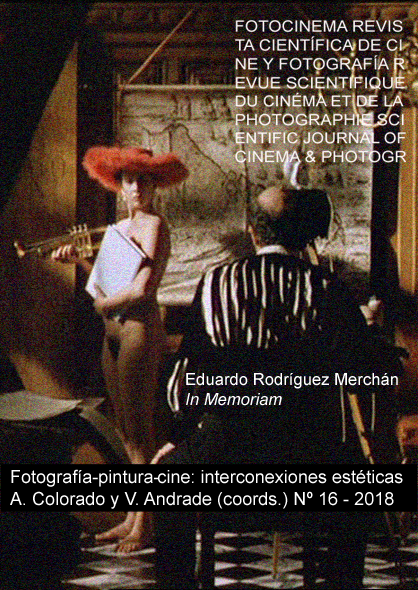La autorreflexión en la comedia clásica argentina
DOI:
https://doi.org/10.24310/Fotocinema.2018.v0i16.4100Palabras clave:
cine clásico argentino, comedia cinematográfica, autorreflexión, industria del entretenimiento, Niní Marshall, Libertad LamarqueResumen
A comienzos de la década de 1940 el cine argentino se encontraba en un proceso de consolidación industrial y aburguesamiento de sus relatos. Frente a ello, los astros populares que habían dominado la producción de los años anteriores se vieron enfrentados a la necesidad de reformular sus personajes y películas para mantener el favor del público. En medio de un escenario donde los empresarios prescindían de ellos y las publicaciones los criticaban, buscaron vías para insertarse en la nueva realidad. Una estrategia recurrente fue la comedia autorreflexiva, a partir de la cual se desmontaron los contratos implícitos con el público y se pusieron en escena los mecanismos internos de la industria del espectáculo. En estos films explicitaban para el público las transformaciones del campo y sus posibilidades individuales de incorporación en el mismo. Estrellas como Niní Marshall y Libertad Lamarque apelaron a este tipo de cine para ensayar alternativas, mostrar sus limitaciones y exhibir la artificialidad de las convenciones de la industria del cine.
Descargas
Métricas
Publicación Facts
Perfil de revisores N/D
Información adicional autores
Indexado: {$indexList}
-
Indexado en
- Sociedad Académica/Grupo
- N/D
- Editora:
- Universidad de Málaga
Citas
Echart, P. (2005). La comedia romántica de Hollywood de los años 30 y 40. Madrid: Cátedra.
España, C. (2000). Pepe Arias. En C. España (Comp.), Cine argentino. Industria y clasicismo. 1933-1956. Tomo I (pp.168-170). Buenos Aires: Fondo Nacional de las Artes.
Feuer, J. (1995). The self-reflexive musical and the myth of entertainment. En B.K. Grant (Ed.), Film Genre Reader II (pp.441-455). Austin: University of Texas Press.
Gil Mariño, C. (2015). El mercado del deseo. Tango, cine y cultura de masas en la Argentina de los ’30. Buenos Aires: Editorial Teseo.
Karush, M. (2012). Culture of Class. Radio and Cinema in the Making of a Divided Argentina, 1920-1946. Durham: Duke U. Press.
Kelly Hopfenblatt, A. (2014). Un modelo de representación para la burguesía: La reformulación de identidades y espacios en el cine de ingenuas. Imagofagia. Revista de la Asociación Argentina de Estudios de Cine y Audiovisual, 10. http://asaeca.org/imagofagia/index.php/imagofagia/article/view/629/539
Kelly Hopfenblatt, A. (2015). Un cine en transición: el aburguesamiento del cine argentino visto a través de las revistas especializadas. Imagofagia. Revista de la Asociación Argentina de Estudios de Cine y Audiovisual, 12. http://www.asaeca.org/imagofagia/index.php/imagofagia/article/view/827
King, G. (2002). Film Comedy. London: Wallflower Press.
Lamarque, L. (1986). Libertad Lamarque. Buenos Aires: Juan Vergara.
Manetti, R. (2000). Argentina Sono Film. Más estrellas que en el cielo. En C. España (Comp.), Cine argentino. Industria y clasicismo. 1933-1956. Tomo I (pp.162-221). Buenos Aires: Fondo Nacional de las Artes.
Morales, I. (2016). Luis Saslavsky: Hollywood vivido e imaginado. AURA. Revista de Historia y Teoría del Arte, 4, 31-53. http://www.ojs.arte.unicen.edu.ar/index.php/aura/article/view/328
Paladino, D. (1999). Libertad Lamarque, la reina de la lágrima. Archivos de la Filmoteca 31, 60-75. Valencia: Filmoteca de la Generalitat Valenciana.
Pardo, S. (2017). Cine clásico argentino: espacio, mirada y autorreflexividad. Los casos de La trampa y Cosas de mujer. Dixit, 26, 74-83. http://revistas.ucu.edu.uy/index.php/revistadixit/article/view/1339
Rodríguez Riva, L. (2014). Cine, revista, música: la industria cultural en las primeras películas de Luis César Amadori. En R. Manetti y L. Rodríguez Riva (Comp.), 30-50-70. Conformación, crisis y renovación del cine industrial argentino y latinoamericano, (pp.49-71). Buenos Aires: Editorial de la Facultad de Filosofía y Letras, Universidad de Buenos Aires.
Savran, D. (2009). Highbrown/Lowdown. Theater, Jazz and the Making of the New Middle Class. Ann Arbor: The University of Michigan Press.
Tranchini, E. (1999). El cine argentino y la construcción del imaginario criollista. En El cine argentino y su aporte a la identidad nacional (pp.101-173). Buenos Aires: Honorable Senado de la Nación.
Publicado
Cómo citar
Número
Sección
Licencia
Todos los contenidos publicados en Fotocinema. Revista científica de cine y fotografía están sujetos a la licencia Creative Commons Reconocimento-NoComercia-Compartirigual 4.0 cuyo texto completo puede consultar en <http://creativecommons.org/licenses/by-nc-sa/4.0>
Se pueden copiar, usar, difundir, transmitir y exponer públicamente, siempre que:
- Se cite la autoría y la fuente original de su publicación (revista, editorial y URL de la obra).
- No se usen para fines comerciales.
- Se mencione la existencia y especificaciones de esta licencia de uso.
Los derechos de autor son de dos clases: morales y patrimoniales. Los derechos morales son prerrogativas perpetuas, irrenunciables, intransferibles, inalienables, inembargables e imprescriptibles. De acuerdo con la legislación de derechos de autor, Fotocinema. Revista científica de cine y fotografía reconoce y respeta el derecho moral de los autores/as, así como la titularidad del derecho patrimonial, el cual será cedido a la Universidad de Málaga para su difusión en acceso abierto. Los derechos patrimoniales, se refieren a los beneficios que se obtienen por el uso o divulgación de las obras. Fotocinema. Revista científica de cine y fotografía se publica en open access y queda autorizada en exclusiva para realizar u autorizar por cualquier medio el uso, distribución, divulgación, reproducción, adaptación, traducción o transformación de la obra.
Es responsabilidad de los autores/as obtener los permisos necesarios de las imágenes que están sujetas a derechos de autor.














13.png)



